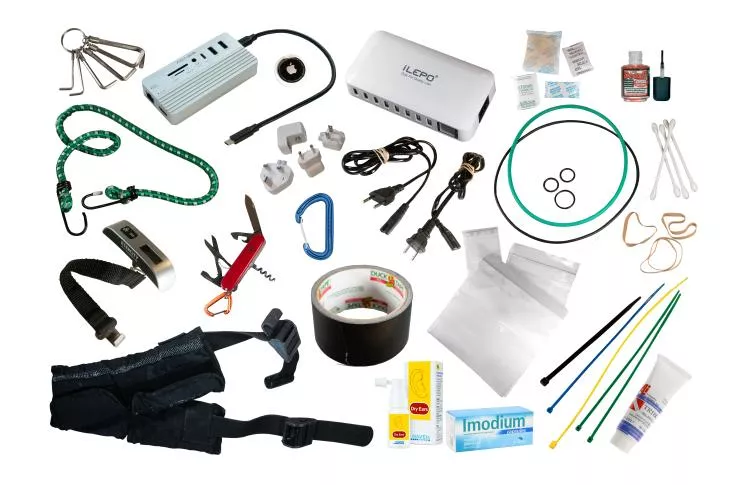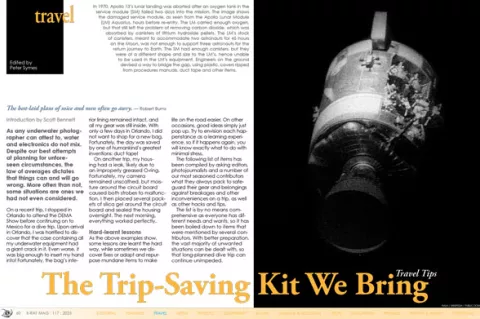As any underwater photographer can attest to, water and electronics do not mix. Despite our best attempts at planning for unforeseen circumstances, the law of averages dictates that things can and will go wrong. More often than not, some situations are ones we had not even considered. Peter Symes and Scott Bennett report.
Contributed by
The best-laid plans of mice and men often go awry. Robert Burns
On a recent trip, I stopped in Orlando to attend the DEMA Show before continuing on to Mexico for a dive trip. Upon arrival in Orlando, I was horrified to discover that the case containing all my underwater equipment had a giant crack in it. Even worse, it was big enough to insert my hand into! Fortunately, the bag’s interior lining remained intact, and all my gear was still inside. With only a few days in Orlando, I did not want to shop for a new bag. Fortunately, the day was saved by one of humankind’s greatest inventions: duct tape!
On another trip, my housing had a leak, likely due to an improperly greased O-ring. Fortunately, my camera remained unscathed, but moisture around the circuit board caused both strobes to malfunction. I then placed several packets of silica gel around the circuit board and sealed the housing overnight. The next morning, everything worked perfectly.
Hard-learnt lessons
As the above examples show, some lessons are learnt the hard way, while sometimes we discover fixes or adapt and repurpose mundane items to make life on the road easier. On other occasions, good ideas simply just pop up. Try to envision each happenstance as a learning experience, so if it happens again, you will know exactly what to do with minimal stress.
The following list of items has been compiled by asking editors, photojournalists and a number of our most seasoned contributors what they always pack to safeguard their gear and belongings against breakages and other inconveniences on a trip, as well as other hacks and tips.
The list is by no means comprehensive as everyone has different needs and wants, so it has been boiled down to items that were mentioned by several contributors. With better preparation, the vast majority of unwanted situations can be dealt with, so that long-planned dive trip can continue unimpeded.
Bungee cords
Eminent in keeping your kit together, both above and below the water, i.e. to keep wing, harness, hoses and straps snuggly bundled up during transport. Underwater, I use one to tuck my long hose under, so it does not dangle about where it can get snared, keeping me more streamlined. Found in hardware stores, gas or petrol stations and other shops.
Swiss Army knife
The Swiss Army knife is such a classic that it has even become a term in itself. It is also smaller and a lot lighter than Leatherman and other multitools.
Carabiner
We've only got two hands but some of us have plenty of D-rings on our BCD or harness onto which stuff can be clipped in a pinch. To this end, a carabiner tied to, say, a bungee cord, can be used to clip on anything handheld such as a camera, a dive lamp or mesh bag. Make sure you get the corrosion-resistant quality.
Weight belt with pouches
There are two reasons why I always pack this old weight belt, even before a suit. One is the buckles that can be both released and tightened with one hand, which is both safer and more comfortable. It also makes it much easier to adjust one’s weight on the spot. Not to mention, it is a pet peeve of mine to have to thread weights onto standard issue weight belts every morning at some dive centres.
USB charging hub
Rather than travelling with a whole bunch of chargers for each of your computers, phones, cameras and other electronic gadgets as well as assorted battery chargers, a charging hub can take care of all of these needs at once. This also does away with a lot of electric cords. This hub just takes a universal cord, such as the ones shown on the right. Charging hubs come in many sizes and capacities, but the model depicted below costs around €20
to €30.
Charging cords with local prongs
Instead of bringing a handful of travel plug adapters, consider just getting charging cords that fit the local electical sockets. The image above shows a pair, one with European prongs on the left, and the other a US version on the right. Each of these plug right into, say, the USB charging hub shown on the left—the socket is on the right end—or a multitude of chargers. Available in hardware stores on location or online for a couple of euros or dollars.
Exchangable prongs
Shown here is a charger for Apple devices (top). The prongs are detachable and can be exchanged for a local version. This set was sold as a “travel kit” with a UK, European and US prong.
Cable ties
A little bunch of cable ties do not take up much space but can come in handy for all sorts of impromtu repairs, tieing things together, keeping houses or cables routed snuggly, or closing things up. There is even a version that is reusable.
Duct or gaffer tape
On the famous Apollo 13 mission, the astronauts fashioned duct tape and surplus materials into air filtration canisters in the lunar module to keep all three astronauts alive for the entire trip home. Less dramatically, dive travellers have used duct tape to patch together broken luggage, ripped suits and cracked equipment.
Allen keys
A small set of Allen keys is not a heavy tool set for all contingencies but is ideal for those delicate small screws inside camera housings and the like.
Power bank
Many of us now travel with a whole array of electronic devices, and while en route or on location, we may find ourselves under circumstances where we cannot recharge devices that are running out of juice. To that end, bring a power bank with a high capacity, say 20,000mAH. Remember, as per airline regulations, batteries and power banks must be carried in carry-on luggage and not in any checked bags.
Luggage scale
Who does not dread the encounter with the overzealous check-in counter agent, and perhaps being slapped with nasty fees for exceeding weight limitations (especially for divers travelling with a lot of camera equipment)? Take the uncertainty out of the equation by weighing your own bags beforehand, so you can accurately redistribute weight and belongings amongst your various luggage bags.
Airtags
Once you see your precious dive bags go down the conveyor belt after check-in, you are left crossing your fingers and hoping that your luggage makes it to your destination. An airtag in each of your bags can give you some peace of mind and also help locate luggage that has gone astray. A four-pack is currently priced at US$99.
Silica gel sachets
Save moisture-absorbing silica gel sachets from parcels you receive, instead of throwing them out. After reaching the maximum amount of moisture they can absorb, they can be “recharged” by placing them in the sun or in an oven for a few hours. They weigh next to nothing and can help dry out moisture that has gotten into places it should not be, or even help rescue some flooded equipment.
Elastic bands
Another household item that can come in handy when fixes are needed, or just to keep things organised or closed up. Weight and space is negligible.
Resealable bags
Excellent for keeping your assorted small gadgets organised and dry, or for making sure you do not lose small pieces. Choose reusable, biodegradable or compostable brands of sandwich bags from the supermarket, which will do the trick. Larger freezer bags can also be used for putting dirty or damp clothing, or wet swimwear, in your suitcase without getting the rest of your clothing or stuff wet. Further uses include holding spare batteries and carrying liquids through airport security.
O-rings + lube
We have O-rings in most of our equipment, but the most delicate and critical ones are usually the ones that go into our cameras and video equipment. These also come in very specific sizes, so bring spares for anything that is mission-critical. To save on weight, you can use the same oxygen-compliant lubrication that is needed for regulators and valves, which are oxygen-compliant for all purposes.
Cue tips
Nothing is better at cleaning O-ring grooves. But get the kind that does not unravel easily.
Contact cleaner
Battery charger not working, dive computer not recharging, or flash not firing? Perhaps a bit of corrosion has materialised on the contacts.
Meds
Should we be giving medical advice? No, and we are not. Initially, we were not going to mention any medical remedies, but it turns out that the following over-the-counter meds are almost universally found in our team members’ bags: Imodium against travel diarrhea, bug repellant and ear drops to prevent swimmer’s ear. Note: Products depicted are just samples. We do not endorse or recommend any specific product.































